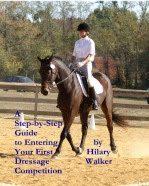Here are my notes - I hope some you find some of them useful.
Specific Issues
First Horse
This was a young horse with lovely movement in walk and trot, but a weak canter.
Improving the Canter
• Cesar told the rider to work on her horse's trot for several months, to strengthen the horse before asking for canter again.
• For homework he told her to work the horse in shoulder-in away from and facing the wall to change his muscle memory. This would enable him to approach canter work afresh.
• He also suggested lungeing the horse before riding.
Second Horse
An established Third Level gelding,
Bending and ‘Giving’
• When bending the horse, the outside rein must remain in strong, steady contact – without moving the hand forward – otherwise the horse won't give into that rein.
• The horse’s head must remain straight in the bend, not tipped to one side. Otherwise it is an evasion and not true acceptance of the outside rein.
• When the horse gives to the outside rein, the rider can give, too. But we need to appreciate the big difference between ‘giving’ and ‘throwing away the contact’. Giving with the hands is a slight easing of rein tension, not a loose rein.
• We should give with our hands every chance we get. When the horse learns to relax - without taking hold - he also learns to accept the giving as a reward.
Third Horse
Working at Prix St. George level.
Canter Pirouettes
The rider was having problems getting her horse to submit to the right outside rein in canter pirouettes.
Cesar had her walk the horse in a 10 meter circle with haunches in, then go into canter from walk, still keeping the haunches in WITH LOTS OF OUTSIDE REIN on the ten meter circle.
(I've watched Cesar giving lessons at his New Jersey barn, and his big issue with canter pirouettes is frequently the rider's insufficient outside rein.)
Tempi
For the flying changes the rider’s legs should move ‘like windshield wipers’ in the moment of change, rather than the huge leg and body movements one sees in some riders.
General Themes/Observations
Emotions
• Don’t take it personally when the horse doesn’t do as you ask.
• Don’t hold a grudge against the horse after corrections. Quickly regain your calm.
Quickness
A theme throughout was that we riders are too slow to react to the horse and make things happen. We need to be much more alert and reactive, without being hurried.
Work Less for More Results
The aim is to work less as a rider for more reaction from the horse.
Forward, Forward, Forward!
This was another constant theme running through the clinic.
• If the horse is sluggish off the leg, take both legs away and kick. Keep doing this until the horse reacts as soon as you simply take your legs off.
• Get the horse moving forward before all else. There is nothing to work with until the horse is doing this.
• Get the horse moving from freer shoulders.
Half-Halts
Get the horse sensitive to the half-halts: be dramatic with them if the horse doesn’t listen. The half-halts must come through!
The Whip
Get the horse to react to a touch of the whip. This way we can use it as an aid, not as a punishment, with just a light request.
Reins First
This is a difficult concept for those of us who were trained in the German fashion which dictates ‘applying as much or more leg as we hold with our hands.’ But most of us aren’t strong enough to do this.
So Cesar advocates getting the horse to come back ONLY WITH THE REINS. Then, when he is light in front, ask him to go forwards off the leg and seat.
This makes the horse much easier to ride.
Constantly Adjust
Keep making little adjustments while riding, testing the horse’s flexibility in the head and neck, or rebalancing him.
Lateral Flexion
Continually test the left and right lateral flexion in the horse, in all three gaits. Make sure the horse is supple and ready for any new movement.
 |
| Cruz Bay still looking supple today after working hard! |



